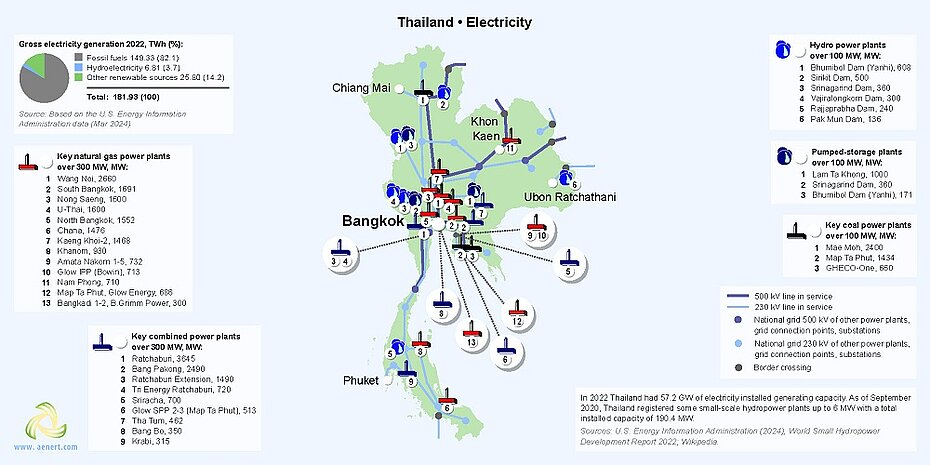Thailand's emerging energy storage sector
Date:2024-12-24
Thailand's grid remains heavily reliant on fossil fuels, with natural gas accounting for 57 per cent of generation and domestic coal accounting for an additional 15 per cent. Renewables only account for ten per cent of overall generation. Solar and wind, the two key variable renewable energy (VRE) technologies which have been facilitating grid decarbonisation around the world in recent years, only account for a total of four per cent of Thailand's current electricity output.
Thailand's decarbonisation commitments in its Nationally Determined Contributions (NDCs) under the Paris Agreement have triggered new rounds of renewable energy deployment, with over eight GWp of greenfield wind and solar projects announced or in the procurement pipeline. Moreover, a revision to Thailand's Power Development Plan (PDP) is expected in early 2024, meaning amended renewable targets are likely to be announced, allowing additional wind and solar to be procured. Some of the foreseeable opportunities in the near future are set out below.
Ground-Mounted PV Solar + Battery Energy Storage Systems (BESS):
As part of the renewable energy procurement round in 2022, the government awarded projects to 24 solar plus co-located BESS projects, with a total capacity of 994 MW.
Pumped hydro storage:
The Ministry of Energy and EGAT have reportedly been considering the impact of deploying additional pumped storage hydropower in order to improve grid flexibility. This would align well with government ambitions to install floating solar on hydropower dams operated by EGAT, with plans to build over 2.7 GWp of floating solar capacity by 2037.
Heat storage:
Thailand's current thermal power plants typically supply heat (along with power) to purchasers in neighbouring industrial estates. As the energy transition results in fewer power plants fuelled by coal and natural gas, industry will need to procure heat from alternative sources.
Power sector liberalisation:
Regulations in Thailand already permit behind-the-grid technologies such as rooftop solar and storage to be deployed, subject to the Energy Regulatory Commission (ERC)'s licensing regime. However, many small to medium-sized buildings are not attractive behind-the-meter developers, since excess power cannot be sold to the grid or to third parties via grid infrastructure.
Energy storage is in its infancy in Thailand, and new business models are already emerging. As the regulatory framework adapts to accommodate new players in the market, it is expected to see greater penetration in this area.
-----------------------------------------------------------------------
กริดของประเทศไทยยังคงพึ่งพาพลังงานฟอสซิลเป็นหลัก โดยก๊าซธรรมชาติคิดเป็น 57 เปอร์เซ็นต์ของการผลิตไฟฟ้า และถ่านหินในประเทศคิดเป็นอีก 15 เปอร์เซ็นต์ ส่วนพลังงานหมุนเวียนคิดเป็นเพียง 10 เปอร์เซ็นต์ของการผลิตไฟฟ้ารวม โดยพลังงานแสงอาทิตย์และพลังงานลม ซึ่งเป็นเทคโนโลยีพลังงานหมุนเวียนที่มีการเปลี่ยนแปลงสูง (VRE) ที่ช่วยกระบวนการลดคาร์บอนของกริดทั่วโลกในช่วงไม่กี่ปีที่ผ่านมา กลับมีสัดส่วนเพียง 4 เปอร์เซ็นต์จากการผลิตไฟฟ้าของประเทศไทยในปัจจุบัน
ภารกิจลดคาร์บอนของประเทศไทยภายใต้ความตกลงปารีส (NDCs) ได้กระตุ้นให้เกิดการติดตั้งพลังงานหมุนเวียนใหม่ โดยมีโครงการพลังงานลมและแสงอาทิตย์เขียวมากกว่า 8 GWp ที่ประกาศหรืออยู่ในขั้นตอนการจัดซื้อ นอกจากนี้ การปรับปรุงแผนพัฒนากำลังไฟฟ้าของประเทศไทย (PDP) คาดว่าจะมีขึ้นในต้นปี 2024 ซึ่งหมายความว่าเป้าหมายพลังงานหมุนเวียนจะได้รับการปรับปรุงและสามารถเพิ่มการจัดซื้อพลังงานลมและแสงอาทิตย์ได้ โอกาสบางประการที่สามารถคาดการณ์ได้ในอนาคตอันใกล้มีดังนี้
ระบบพลังงานแสงอาทิตย์แบบติดตั้งพื้นดิน + ระบบเก็บพลังงานด้วยแบตเตอรี่ (BESS): ในส่วนของการจัดซื้อพลังงานหมุนเวียนในปี 2022 รัฐบาลได้มอบโครงการให้กับ 24 โครงการพลังงานแสงอาทิตย์พร้อมระบบเก็บพลังงาน BESS รวมกำลังผลิต 994 เมกะวัตต์
การเก็บพลังงานจากพลังน้ำ (Pumped Hydro Storage): กระทรวงพลังงานและการไฟฟ้าฝ่ายผลิตแห่งประเทศไทย (EGAT) ได้พิจารณาผลกระทบจากการติดตั้งระบบเก็บพลังงานจากพลังน้ำเพิ่มเติมเพื่อปรับปรุงความยืดหยุ่นของกริด ซึ่งจะสอดคล้องกับเป้าหมายของรัฐบาลในการติดตั้งพลังงานแสงอาทิตย์ลอยน้ำบนเขื่อนพลังน้ำที่ดำเนินการโดย EGAT โดยมีแผนการสร้างกำลังการผลิตพลังงานแสงอาทิตย์ลอยน้ำมากกว่า 2.7 GWp ภายในปี 2037
การเก็บความร้อน: โรงไฟฟ้าพลังความร้อนในปัจจุบันของประเทศไทยมักจะจัดหาความร้อน (พร้อมกับไฟฟ้า) ให้กับผู้ซื้อในนิคมอุตสาหกรรมข้างเคียง เมื่อการเปลี่ยนแปลงพลังงานทำให้มีโรงไฟฟ้าที่ใช้ถ่านหินและก๊าซธรรมชาติน้อยลง อุตสาหกรรมจะต้องหาซื้อความร้อนจากแหล่งอื่น
การเปิดเสรีภาคพลังงาน: กฎระเบียบในประเทศไทยได้อนุญาตให้มีการใช้เทคโนโลยีที่อยู่หลังมิเตอร์ เช่น โซลาร์รูฟท็อปและระบบเก็บพลังงาน โดยต้องได้รับการอนุมัติจากคณะกรรมการกำกับกิจการพลังงาน (ERC) อย่างไรก็ตาม อาคารขนาดเล็กและขนาดกลางหลายแห่งไม่ใช่ผู้พัฒนาโซลาร์ที่ดึงดูดเนื่องจากไม่สามารถขายพลังงานที่เกินความต้องการกลับสู่กริดหรือแก่บุคคลที่สามผ่านโครงสร้างพื้นฐานกริดได้
การเก็บพลังงานยังอยู่ในช่วงเริ่มต้นในประเทศไทย และมีรูปแบบธุรกิจใหม่ๆ ที่เริ่มเกิดขึ้นแล้ว เมื่อกรอบกฎระเบียบปรับตัวเพื่อรองรับผู้เล่นใหม่ในตลาด คาดว่าจะมีการเติบโตอย่างมากในด้านนี้

More info on: https://www.adb.org/news/adb-gulf-sign-820-million-loan-scale-solar-and-battery-storage-thailand

 Location >>
Location >> 
